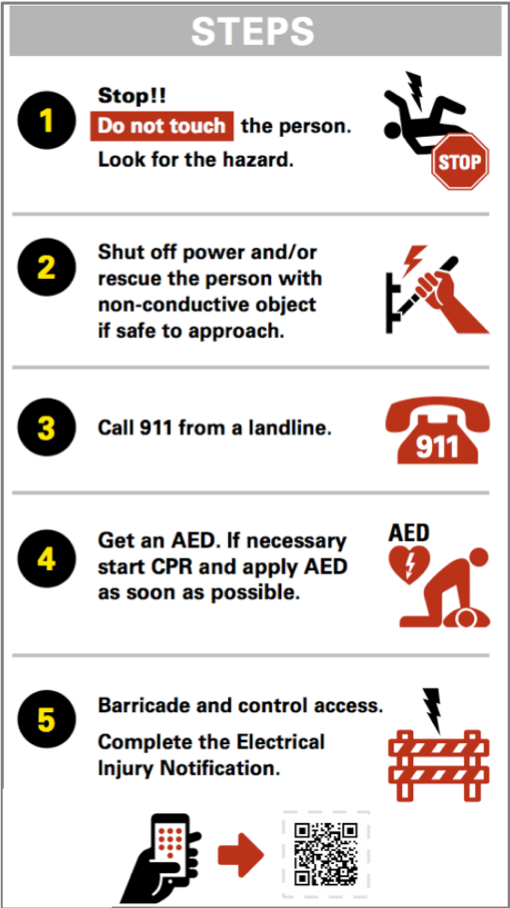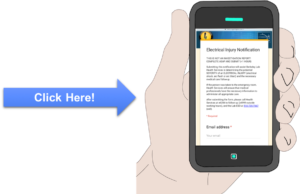FG-00 Field Guide – Emergency Response

Electrical Injury Notification Form
THIS IS NOT AN INVESTIGATION REPORT! COMPLETE ASAP AND SUBMIT (<1 HOUR)
Submitting this notification will assist Berkeley Lab Health Services in determining the potential SEVERITY of an ELECTRICAL INJURY (electrical shock, arc flash or arc blast) and the necessary medical care follow up.
If the person was taken to the emergency room, Health Services will ensure that medical professionals have the necessary information to administer all appropriate care.
After submitting the form, please call Health Services at 510-486-6266 to follow up (510-486-6999 outside working hours), and the Lab ESO at 510-210-2735 (cell). See example of a completed form.
FOR MINOR SHOCKS
- All shocks must be reported! Notify your supervisor.
- During normal hours, if the person does not require emergency medical attention (see note below), escort the person to Health Services:
- Call ahead: 510-486-6266
- The escort should be CPR trained if possible.
- Outside normal hours, call 911 instead.
- Health Services Hours: M-F 7:00 AM — 4:30 PM
- Complete an Electrical Injury Notification
NOTE: The following are NOT minor shocks! Call 911 IMMEDIATELY regardless of apparent severity or injury:
- Any loss of consciousness (even if employee is subsequently awake and talking)
- Any reported or witnessed prolonged contact (unable to let go)
- Any fall or trauma
- Obvious burn injury
- All high voltage incidents (greater than 750 volts) or lightning strikes
IF IN DOUBT, CALL 911
FACTS
- A person receiving a shock may not be able to let go until power is shut off.
- A landline is the best way to ensure fastest response by EMS because it goes straight to a local dispatcher and registers the exact location.
- Staying or laying on a grounded metal platform or object is just as bad, or worse, than standing in water because it will cause a much high shock current.
- A severe shock can cause heart fibrillation. Delayed heart fibrillation may occur up to 24 hours after a shock, so evaluation by health professional is required (an EKG will be performed).
- Even if fibrillation does not occur, severe shocks can cause significant internal cellular damage. Symptoms may take a few days to develop.
- If heart is fibrillating, an AED should be applied as soon as possible for best outcome, before organ damage starts to occur. Of no AED is available, continue CPR until EMS arrives.
- A fire extinguisher may be necessary if clothing is on fire.
DOs & DON’Ts
- DO include the emergency response plan in the job briefing.
- DO NOT touch the person until power is off or the source is removed.
- DO look for electrical hazards such as water on the floor, wires and cords, and open panels.
- DO NOT approach a victim on a metal deck or walk into water unless power is shut off.
- DO use a landline when possible to ensure fastest response time. Use a cell if necessary, ensure location is understood! Verify cell signal.
- DO NOT pull the fire alarm since this will evacuate the building and confuse the response.
- DO ask others present to help call 911 and get the AED.
- DO NOT send the person away in a taxi or personal vehicle. Use the EMS ambulance.
- DO call for electrical support ASAP: Facilities, Engineering, EHS, or any QEW.
QEW PRE-JOB EMERGENCY PREPARATION
- Power shut off / disconnect nearby and/or rescue hook available?
- Landline phone available for 911? Or does cell phone have strong signal?
- Clear exit path?
- AED nearby?
- Fire extinguisher nearby?
- Second person identified, trained, and briefed?

